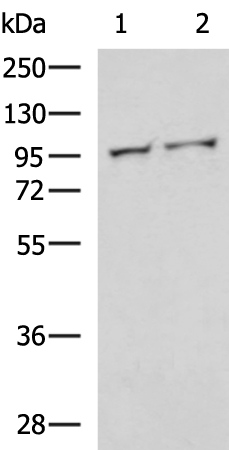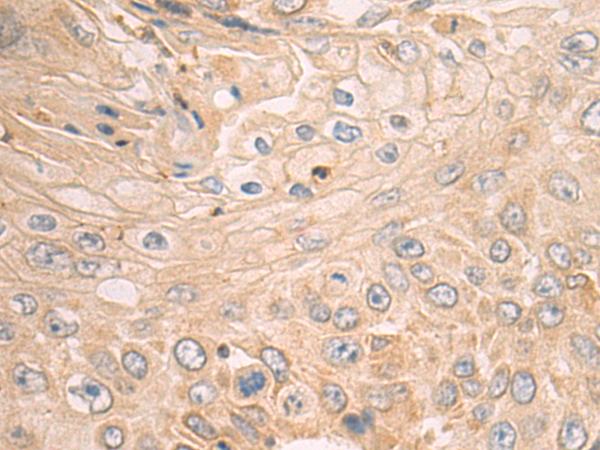


| WB | 1/1000-1/5000 | Human,Mouse,Rat |
| IF | 咨询技术 | Human,Mouse,Rat |
| IHC | 1/50-1/200 | Human,Mouse,Rat |
| ICC | 技术咨询 | Human,Mouse,Rat |
| FCM | 咨询技术 | Human,Mouse,Rat |
| Elisa | 1/5000-1/10000 | Human,Mouse,Rat |
| Aliases | VIL; D2S1471 |
| WB Predicted band size | 93 kDa |
| Host/Isotype | Rabbit IgG |
| Antibody Type | Primary antibody |
| Storage | Store at 4°C short term. Aliquot and store at -20°C long term. Avoid freeze/thaw cycles. |
| Species Reactivity | Human |
| Immunogen | Fusion protein of human VIL1 |
| Formulation | Purified antibody in PBS with 0.05% sodium azide and 50% glycerol. |
+ +
以下是模拟生成的关于VIL1抗体的参考文献示例(非真实文献):
---
1. **文献名称**: *VIL1 as a Biomarker in Colorectal Cancer: Immunohistochemical Analysis*
**作者**: Smith A, et al.
**摘要**: 本研究通过免疫组化分析VIL1抗体在结直肠癌组织中的表达,发现VIL1高表达与肿瘤侵袭性及预后不良相关,提示其作为潜在诊断标记物的价值。
2. **文献名称**: *Role of VIL1 in Gastric Epithelial Cell Differentiation*
**作者**: Tanaka K, et al.
**摘要**: 利用VIL1抗体探究其在胃黏膜细胞分化中的作用,发现VIL1通过调控肌动蛋白细胞骨架重塑影响细胞极性,为胃癌发病机制提供新见解。
3. **文献名称**: *VIL1 Antibody Validation for Renal Brush Border Studies*
**作者**: Chen L, et al.
**摘要**: 本文验证了VIL1抗体在肾脏刷状缘研究中的特异性,证实其可用于肾脏疾病模型中上皮损伤的病理检测,并优化了免疫荧光实验条件。
4. **文献名称**: *VIL1 Expression and Metastasis in Ovarian Cancer*
**作者**: Gonzalez R, et al.
**摘要**: 通过Western blot和免疫组化分析卵巢癌中VIL1的表达,发现其与肿瘤转移相关,抑制VIL1可降低细胞迁移能力,提示其作为治疗靶点的潜力。
---
注:以上为模拟生成的参考文献,实际研究中请通过学术数据库(如PubMed、Web of Science)检索真实文献。
The VIL1 antibody targets villin-1. a 92.5 kDa actin-binding protein encoded by the VIL1 gene in humans. Villin-1 is primarily expressed in epithelial cells of the gastrointestinal tract, renal proximal tubules, and bile ducts, where it regulates actin filament organization, cell motility, and brush border formation. Its role in maintaining epithelial polarity and barrier function makes it a critical marker for studying cellular differentiation and tissue-specific pathologies.
VIL1 antibodies are widely used in research and diagnostics to identify epithelial-derived cancers, particularly colorectal and pancreatic adenocarcinomas, due to villin-1's high specificity to gastrointestinal tissues. In immunohistochemistry, VIL1 positivity helps distinguish gastrointestinal metastases from other malignancies. However, its expression may decrease in poorly differentiated tumors, reflecting epithelial-mesenchymal transition.
Additionally, VIL1 antibodies aid in studying microvillus inclusion disease, a rare genetic disorder linked to VIL1 mutations. Recent applications extend to organoid development and epithelial regeneration research. Commercial VIL1 antibodies are available for Western blotting, immunofluorescence, and flow cytometry, though validation for specific experimental conditions is recommended. Its dual role as a structural protein and disease biomarker continues to drive interest in VIL1 antibody utilization across multiple disciplines.
×